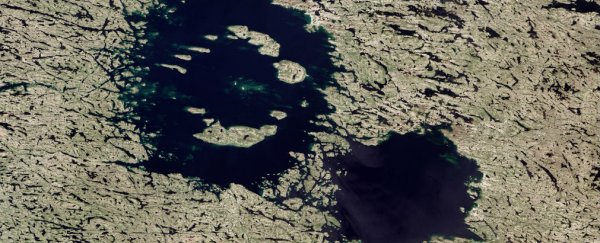The Clearwater lakes in northern Quebec, Canada, is actually a single body of water that fills up two large depressions in Earth's surface. From space, these circular blue lakes stand out against the forest-green landscape. The western lake is about 36 kilometres wide (22.5 miles) with a ring of islands in the centre. It is separated from the the slightly smaller eastern lake by a thin strip of green islands, which measure about 10 km across.
It has long been thought that these two craters, because of their amazingly close proximity, were created by a binary asteroid system, which saw twin meteorites impact Earth simultaneously around 290 million years ago.
But new research suggests that these craters were in fact the result of two separate impact events, with the eastern lake forming more than 180 million years earlier, when much of eastern Canada was covered by a shallow ocean.
A team of geologists from the University of Western Australia has analysed rock samples collected by the Canadian Geological Survey in the 1960s and 1970s. They used a radioactive dating technique, which involved heating the rock samples to release the isotopes argon-39 and argon-40. This enabled them to measure the amount of potassium that was once present in the sample, and subsequently, determine the age of the rocks.
While their dates line up for the western lake, which formed around 290 million years ago during the Permian time period, their findings suggest the eastern lake must have formed after a separate impact, which occurred around 470 million years ago, during the Ordovician period.
The authors say their "paleogeographic reconstructions show that the Ordovician East Clearwater impact probably occurred in a near-coastal to shallow marine setting, while the Permian West Clearwater impact hit continental Pangaea."
 Clearwater lakes in Quebec, Canada (Credit: NASA)
Clearwater lakes in Quebec, Canada (Credit: NASA)
The team's findings, which have been published in the journal Geochimic et Cosmochimi ca Acta, go against the prevailing theory of the double impact.
"The idea that a meteorite could hit very close to a previous meteorite has always been dismissed or considered to be so improbable as to be impossible," geologist Eric Tohver from the University of Western Australia told Science Network Western Australia.
"Overall, the doublet theory has been so compellingly advocated over the decades that alternative scenarios seem to have been abandoned," lead author Martin Schmieder told Amanda Doyle from Astrobiology Magazine. "In our view, there is a whole line of geologic evidence that argues against the double impact."
The authors say their findings "suggest that the close spatial arrangement of the two Clearwater Lakes is most likely pure coincidence" and that the "two impact structures seem to represent a 'false doublet' struck by impacts separated by around 180 million years in time."
As Doyle explains for Astrobiology Magazine, the age of the western lake isn't really disputed as several different rock samples all indicate that the crater was formed around 290 million years ago. But the age of the eastern crater is much more difficult to determine.
Researchers had previously pegged the impact for the east lake at 290 million years ago, but in 1990 a research team using a different dating method suggested it could have occurred 460 million years ago. As Doyle writes in Astrobiology Magazine, the team eventually "assumed it to be incorrect out of suspicion that excess argon was contaminating the sample and mimicking an older age for the crater."
But Schmieder and his team thought this uncertainty warranted another look and set about testing their hypothesis that the craters were formed not by a single event, but by different impacts millions of years apart. And however unlikely it may seem, their data suggests that asteroids can strike the same spot twice.
Sources: Astrobiology Magazine, Science Network Western Australia
